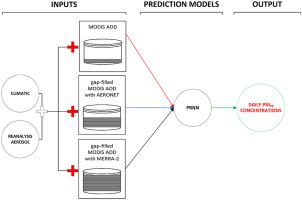Atmospheric Environment ( IF 4.2 ) Pub Date : 2021-06-25 , DOI: 10.1016/j.atmosenv.2021.118562 Gizem Tuna Tuygun , Serdar Gündoğdu , Tolga Elbir

|
Satellite-derived aerosol optical depth (AOD) products are widely used to estimate the spatial and temporal characteristics of ground-level particulate matters (PM). Satellite-based approaches in the operational use of PM estimation models have limitations such as missing values in satellite-based variables due to the impact of cloud cover, relative humidity, and aerosol vertical distribution. Therefore, the spatial-temporal resolution of the estimation models is forced to be improved by using AOD products having different temporal resolutions from different platforms. In this study, ground-based PM10 concentrations were aimed to be estimated using different gap-filled AOD datasets between 2008 and 2016 over a coastal site in the Eastern Mediterranean. For the estimation of PM10 concentrations, daily AOD data were mainly used from MODIS. Then, two different gap-filled MODIS AOD datasets with both AERONET and MERRA-2 AODs were also examined separately on both multi-annual and multi-seasonal basis since the number of MODIS AOD data was temporally limited in the region. A pattern recognition neural network (PRNN) model was used for the estimation of PM10 concentrations. AOD with several meteorological parameters from an on-site meteorological station and aerosol diagnostic products from MERRA-2 were used as inputs to the estimation model. The most significant variables for the model were identified in 23 independent variables using the multiple linear regression (MLR). The results indicated that the best estimation (R = 0.74) was obtained with the gap-filled AODMODIS+MERRA dataset for the period covering all years whereas the AODMODIS dataset alone showed the poorest performance (R = 0.62). However, the performance of the gap-filled datasets varied with the seasons. For example, the AODMODIS dataset alone showed the best estimation performance (R = 0.67) in the summer whereas the gap-filled AODMODIS+AERONET dataset had the best performance (R = 0.59) in the winter. Overall results suggest that for estimating ground-level PM concentrations, an approach of gap-filled AOD dataset usage for estimation models is useful especially in rainy seasons such as the winter and autumn where MODIS AOD retrievals are limited.
中文翻译:

基于协同使用 MODIS、MERRA-2 和 AERONET AOD 在东地中海沿岸地区估算地面颗粒物浓度
卫星衍生的气溶胶光学深度(AOD)产品被广泛用于估计地面颗粒物(PM)的时空特征。由于云量、相对湿度和气溶胶垂直分布的影响,基于卫星的方法在 PM 估计模型的操作使用中存在局限性,例如卫星变量中的缺失值。因此,必须通过使用来自不同平台的具有不同时间分辨率的 AOD 产品来提高估计模型的时空分辨率。在这项研究中,地面 PM 10浓度旨在使用 2008 年至 2016 年间在地中海东部沿海地区的不同间隙填充 AOD 数据集进行估算。用于估计 PM 10浓度,每日 AOD 数据主要来自 MODIS。然后,由于 MODIS AOD 数据的数量在该地区受到时间限制,因此还分别在多年和多季节的基础上检查了两个不同的具有 AERONET 和 MERRA-2 AOD 的间隙填充 MODIS AOD 数据集。模式识别神经网络 (PRNN) 模型用于估计 PM 10浓度。来自现场气象站的若干气象参数的 AOD 和来自 MERRA-2 的气溶胶诊断产品被用作估算模型的输入。使用多元线性回归 (MLR) 在 23 个自变量中确定了模型最重要的变量。结果表明,使用间隙填充的 AOD MODIS获得了最佳估计值 (R = 0.74)+ MERRA数据集涵盖所有年份,而单独的 AOD MODIS数据集表现最差(R = 0.62)。然而,间隙填充数据集的性能随季节而变化。例如,单独的 AOD MODIS数据集在夏季表现出最佳估计性能(R = 0.67),而间隙填充的 AOD MODIS + AERONET数据集在冬季表现最佳(R = 0.59)。总体结果表明,为了估算地面 PM 浓度,估算模型中使用间隙填充 AOD 数据集的方法非常有用,尤其是在 MODIS AOD 反演有限的雨季,例如冬季和秋季。











































 京公网安备 11010802027423号
京公网安备 11010802027423号